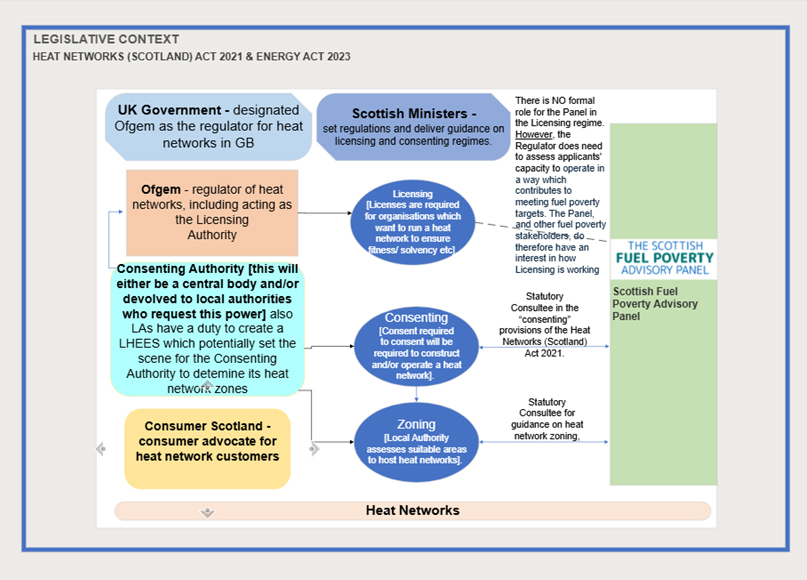This file will open in a new browser tab
Heat Networks
The Panel has held a heat networks’ roundtable with legislative, regulatory, and local authority stakeholders to explore the opportunities and challenges which heat networks present for those in, or at risk of, fuel poverty. This was a highly interactive and thought-provoking session.
The heat network landscape is a complex one with:
- Devolved and reserved powers.
- The interplay of different policy objectives and statutory targets (Fuel Poverty, Terawatt hours of thermal energy through heat networks, Net Zero Emissions etc.).
- The complex array of potential heat network models and,
- The question of how they might be funded.
We have a keen interest in heat networks primarily because of the potential they may offer to alleviate and protect from fuel poverty but also because, in our scrutiny capacity, we are a statutory consultee on aspects of heat network regulations.
The following diagram shows a high-level view of the legislative, regulatory, and local authority roles and responsibilities in the heat networks’ framework and where we fit in.

This diagram is not fully accessible, a fully accessible version can be supplied on request.
Reflecting on what we heard at the roundtable, we are developing our thinking on the potential for heat networks to mitigate fuel poverty. Our early thoughts are that:
- Heat Networks will make an important contribution to decarbonising heat in homes but there is little evidence to suggest that decarbonised heat networks will have a positive impact on reducing levels of fuel poverty.
- There is potential for heat networks to have a detrimental impact on levels of fuel poverty and those experiencing fuel poverty, unless:
- Energy market reforms are expedited to ensure that electricity prices are reduced.
- Regulatory regimes give vulnerable heat network energy consumers, at the very least, equivalent protections to those given to vulnerable energy consumers, including price controls.
- Delivery models have an appropriate scale and significant public ownership or investment as well as offering the potential for community benefits.
- There is some evidence of policy disconnect/dilution – for example, the dissonance between promoting both heat pumps (for individual) households and heat networks (for many households) in an area zoned for heat networks.
You can see a note of our discussion at the roundtable – here, and we are very grateful to those who came along from the Scottish Government, Ofgem, the Scottish Futures’ Trust, Consumer Scotland and Dundee City and East Ayrshire Councils.
